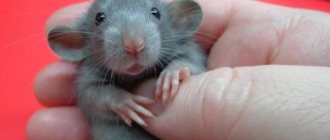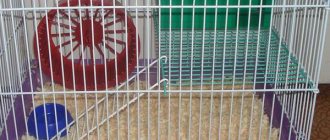- home
- Care
12.04.2018
Having become the happy owner of a small hamster, you would rather take it in your hands, stroke it, caress it. But the rodent does not want to communicate, hides in the house, and if you try to get it out of there, it may bite. Of course, ornamental rodents are less aggressive than their wild relatives, but their teeth are sharp and their bite is painful. This is not the type of communication you dreamed of when you bought a little fluffy dog. In addition, the cage must be cleaned regularly, and the pet will have to be lured out of the home.
In this article we will talk about how to tame a hamster. Be patient and gradually you will win his trust and loyalty.
Taming
The taming process must begin at the time of purchase of the animal.
Moving to a new place is a huge stress. Try to make transportation as comfortable as possible. For this:
- do not catch the animal with your hands, lure it with treats;
- place it in a box or special carrier;
- put some old sawdust and usual food there in advance;
- go home immediately.
Upon arrival, place the box with the animal in the cage. Make sure he has enough water and food for the next 24 hours. After that, leave him alone. The main taming process will begin the next day.
First days in a new house
First, let him wake up. Don't disturb him when he's sleeping. This will be perceived as a sign of aggression.
Place the cage on the floor in a quiet room. Fence off the surrounding area so that the animal cannot escape. Remove the lid from the cage (only the tray should remain). There is no point in opening the door; the rodent will not come into your arms.
Talk to your hamster in a quiet and gentle voice so that he gets used to your presence. Give him something tasty, such as a piece of carrot or apple. Hold the treat in your hand and wait for him to start eating. Try patting him on the back
Do this carefully and avoid sudden movements. It may take several days for him to stop being afraid.
- Stroke the hamster's back from the shoulders to the hind legs. Try not to touch his head.
- Don't point your fingers forward. The animal may mistake them for food and bite you.
How to hold a hamster in your arms
The next step is to try to pick up the rodent. When he is no longer afraid of you, place a tasty seed in your palm. Most likely, he will come to your arms himself
Now it's important not to scare him
- Cup your palms and hold the hamster with its muzzle facing you. Raise it slightly off the floor. You should not raise him more than 20 cm. If he falls from a higher level, he may get hurt.
- Cover it lightly with your palm and stroke the back.
- Let him run from palm to palm, rearranging them.
- If he starts running too fast, block his path with your palm.
- If he doesn't try to escape, sit him on your lap. He might want to climb on your shoulder.
Hold your pet firmly, but do not squeeze, otherwise he may bite.
Features of taming the Syrian hamster
Typically, Syrian hamsters are tamed fairly quickly, as this breed is naturally friendly and curious. To speed up the process, use treats and toys. Try to make communication interesting for the rodent.
The Syrian hamster is larger than other representatives of the species, so the process of taming it can be safely entrusted to a child
It is important not to allow excessive attention to the hamster in the first days of his stay at home
At this time, close attention from the child will be perceived negatively
How to tame a dzhungarika to your hands
Dzungarik is wilder and less amenable to taming. It may take several weeks for him to get used to his owner. Do not try to pick up your baby before he has adjusted to the new place. If you bought a hamster for a small child, make sure that he does not squeeze the animal, as they are very easy to injure.
If you want to hold the animal often, buy one hamster. It is known that animals living in pairs do not make good contact with humans.
Features of some breeds
Getting used to hands after adaptation
Most often, the Djungarian, Syrian and Roborovsky hamsters are kept at home. In general, the algorithm for taming representatives of different breeds is the same. But you need to take into account the characteristics of the breed. So, for example, the Roborovsky hamster is considered the most peaceful. He bites very rarely. Most often, pregnant females show aggression, so taming a rodent of this breed is easy and quick.
The Syrian hamster is more aggressive. Before taming a dwarf Syrian hamster, it should be given enough time to adapt. To speed up the taming process, you should start giving your pet treats outside the cage.
Taming Dzungarik
As for the Dzungarian rodent, it is the most aggressive. Djungarik can only be tamed at a young age. This restive rodent is not inclined to change its habits and lifestyle, so when purchasing, you need to make sure that a young individual is taken into the house.
Let's look at some recommendations from experts who know how to tame a Djungarian hamster.
- Before taming Dzhungarik, they thoroughly wash their hands and rub them with litter in the cage. A familiar smell will inspire confidence in your pet.
- If the rodent behaves too aggressively, at first they put on mittens intended for gardening.
- Dzungarik has poorly developed eyesight, so when getting to know any object he uses smell and touch. Sometimes touching with his paws is not enough for him, and he may bite lightly on the palm. An introductory bite should not be confused with a display of aggression. You should not make any sudden movements, you just need to smoothly move your palm to the side, showing your pet that its bites cause discomfort.
Djungarian hamster
Dzungarian (Russian dwarf) hamsters are tiny animals ranging from 7 to 9 centimeters long. The traditional color is shades of reddish-brown and almost black in the form of a bright stripe on the back. But, in addition to natural, there are three more decorative colors: pearl (white with a gray stripe on the back), tangerine (red) and sapphire (gray-white).
Djungarian hamsters are very social and when kept, they definitely need company. These small furry animals can exist with members of the same sex and the opposite sex. But with the latter, of course, they quickly begin to reproduce, starting from a very young age.
Another name for the Djungarian hamster is “white Russian dwarf hamster”, since it has the peculiarity of changing the color of its coat from gray-brown to white with the onset of winter. But when kept in captivity this happens extremely rarely. Life cycle - 2-2.5 years.
Djungarian hamster (Russian dwarf hamster). AlexEames
Let's get to know each other better
The pet has gotten used to its new home, it’s time to get used to its owners. The time for getting to know each other must be considered, taking into account the daily activity of the animal. Djungarian and Syrian hamsters are crepuscular animals. Don't bother the fluffies during the day, it will only scare them
What can you do to prevent your hamster from being afraid of its owner? There are several points worth paying attention to
Master's voice
At the first stage of acquaintance, you should establish verbal contact with the hamster. He must remember the sound of your voice and get used to it. Talk to the homa calmly and affectionately. Choose a beautiful name and repeat it often
It is especially important to talk to a funny animal while feeding. Then he will begin to associate your voice with the pleasure he receives from goodies.
Tactile contact
Touch is very important in the friendship between owners and pets. Before you think about how to tame a dzhungarika, you need to establish basic body contact. This rule also applies to rodents of other breeds (Syrian, Caucasian, Angora). Hamsters are mistrustful animals; they won’t let just anyone pet them. You need to make sure that the animal trusts you.
The algorithm of actions is as follows:
- You can start by simply placing your hand in the cage. Khoma remembers that these hands usually bring him goodies, so he may become interested and come up to sniff. Let the animal walk around your hand and examine it. At this stage, he may even be tempted to lick his finger - this will be your small victory!
- After some time, you can begin to move your hand in the cage. Bend, straighten your fingers, and turn your hand slowly and smoothly. This way the hamster will understand that you do not want to scare him or cause harm.
- Once your furry dog has become accustomed to feeling safe in your presence, try lightly petting the rodent with one finger. If the animal doesn’t mind, you can touch its nose. But you shouldn’t fiddle with your ears!
Tactile contact has been established, it’s time to think about how to tame a Djungarian or Syrian hamster.
Features of training different types
There are no special recommendations for taming different types of hamsters. For all breeds, the rule is that young individuals master science faster than adults. The more time you spend with the animal, the faster it will get used to you.
And yet it is believed that Djungarian hamsters are more nimble and intelligent, and it is easier to tame a Djungarian than the larger and slower Syrian. In any case, it all depends on the desire and patience of the owner. Any hamster can even be taught to respond to a nickname if you repeat it every time you bring your pet food. This will help bring the rodent back if it runs away.
Advanced maneuvers
Weight lifting
Obviously, rodents should not lift heavy objects. But to create the effect of heaviness, you can make a barbell from foods that hamsters like to chew: carrots, cucumbers, apples, etc. A block is made from an oblong object; salty or sweet sticks can be used as this. Cookies can serve as mini pancakes for your attribute. When the pet sees the “barbell”, he will certainly want to chew on it, to do this he will lift it and a picture of an athlete with a lifted load will be created.
Pirate and parrot
To create the ambience of a pet sitting on the owner’s shoulder, follow the following instructions:
- Place your pet in your palm.
- Bend your elbow slightly and move it away from your body so that the rise is not too steep.
- Lure your pet to your shoulder with sweets and let your hamster eat it.
- Practice each step repeatedly with your pet.
- When the animal understands what the point is, stop luring the hamster with goodies. Instead, just give him a sniff of the food and immediately place the treat on his shoulder.
Soon your little friend will begin to willingly come running on your shoulder even in the absence of sweets.
Jumping through a hoop
If you want to see your animal jump over obstacles, then use a small hoop for this. The diameter of the circle must be at least 7 cm so that the hamster does not get stuck in it.
- Place the hoop between the animal and a piece of food.
- Keep the circle not too high above the floor (about 1 cm), otherwise the pet will run under it.
- Repeat the exercise several times until your pet can do it without a treat.
Barrier!
- Make a simple design from two disposable cups and toothpicks.
- Place a treat outside the barrier and say: “Barrier!”
- To get a tasty morsel, the fluffy will have to overcome an obstacle.
- After several strengthening of the skill, the animal will be able to jump over the barrier itself after a command.
How to train a Djungarian hamster
It is not easy to teach commands to such a restless animal. The intelligence of these rodents is so high that they are able to understand their owner at a glance. But the Dzungarians are so cowardly that training will require remarkable patience. And if the owner has enough strength, attention and patience, the hamster will amaze with its success.
There are both simple and complex commands for animals. You should start with the basic ones. As you achieve certain successes, you can move on to more complex tricks.
A command word during training helps to develop a conditioned reflex in the animal. Pieces of treats will help speed up the learning process. With them the effect will be more obvious. Reproducing the team in the future will not be difficult for Djungarik.
First, some simple tricks:
- Knowing your own nickname. You need to repeat your pet's name clearly and dispassionately. At the same time, you should give him treats in small pieces. The animal should be called by its nickname during any close contact with it, and success should be fueled with treats. Over time, the dwarf will begin to respond to its name and quickly run for its favorite food.
- Stand at attention". The baby needs to be seated on a flat surface and the treat raised a little higher than his head. At this time, say the command “stand.” It will take several days for the hamster to get up at this command without any treat. But from time to time it is better to encourage him.
- Running in circles. The hamster should be placed on a surface with small sides and interested in a treat. As soon as he reaches for food, you need to clearly and loudly say the command “in a circle” and at the same time begin to move your hand with the tasty morsel in a circle. Dzungarik will give chase, and when he stops, he will receive a treat. Repeat the lesson from time to time until the hamster can instantly reproduce what you have learned.
- Somersault. This task is more difficult. The animal should be placed on a flat surface, and the treat should be placed on its back. He will be able to get the desired treat only if he turns over. Once it has returned to its original position, the experiment can be repeated, but do not forget to repeat the command.
Now you can try a trick of increased difficulty. For example, teach your pet to climb onto your shoulder. To do this, you will need to wear a long-sleeved shirt and place the animal in your palm.
The hamster should see a treat that was placed on his shoulder before his eyes and at the same time a command was given. Several times the dzhungarik will climb up the sleeve onto the shoulder to eat a delicacy - this is how he will learn.
How to tame a Syrian hamster: step-by-step method
It is recommended to adapt your furry friend to a new home and family members in stages, always taking into account the mood and behavior of the animal. If the baby is restless and tries to sneak away, there is no need to restrain him. in this case, it is necessary to give the new family member some time to look around and get used to the situation
in this case, it is necessary to give the new family member some time to look around and get used to the situation.
Adaptation period
The very first point in the process of domesticating an animal is its adaptation, during which the pet must come to its senses and calm down, because moving to a new, unfamiliar place is a lot of stress even for people.
When feeding the animal in the first days, it is recommended to carefully place the food in a bowl and move away, giving the new friend the opportunity to eat alone in peace.
Master's voice
In order for the animal to get used to the owner’s voice, recognizing it, it is recommended to talk to the pet daily in a calm voice for 5 minutes. It is advisable to have such conversations several times a day, making sure that the conversation is not too long
You can sing pleasant songs quietly, paying attention to the baby’s behavior.
Hamsters should never be fed waffles.
Treating yourself with a treat
Regularly treating the pet with a tasty treat will create an association of the owner with something pleasant, which will allow the baby to quickly get used to the new home and stop being afraid of the owner.
At first, treats should simply be left in the cage, inserting pieces of fruit or vegetables between the bars. After a few days, you can try placing the treat closer to the exit of the cage, holding the food in your hands for a longer time so that the pet gets used to the owner’s smell.
Feeding outside the cage
When the animal stops showing anxiety and settles into its new home, you can try to feed it outside the cage. Before this, you need to help the animal make sure that no danger awaits it outside the cage. To do this, you need to stick your fingers into the cage, allowing the animal to sniff them. If the hamster becomes restless, it is better to postpone feeding outside the cage for a couple of days.
After carefully removing your furry friend from his house, he should be placed on a flat, not too cold and not too warm surface, and offered a treat. Pieces of non-acidic fruits and vegetables are suitable for treats, especially cauliflower and broccoli, as well as all kinds of nuts, raisins, rose hips and dried apples. Before serving, treats should be chopped to the required size so that the pet can hold each piece in its paws.
Pet in the owner's palm
The best way to accustom an animal to handling is with the help of treats. To do this, you need to pull the hamster out of the cage, first substituting one and then the second palm and, carefully moving the animal onto your hands, place it on the table. As a rule, the baby will try to immediately run away from your hands.
A piece of treat should be placed on an open hand, closer to the fingers. Fluffy will have to come closer and take the treat from his hands. After a while, you can try placing food in the center of your palm. At first, the gourmet may run away with a piece of treat and eat it a little further away. However, having gotten used to the smell and sight of the owner’s hands, the hamster will soon begin to trust so much that he will eat the treat right on the spot, from his hands.
When the animal begins to eat from your hands, you can try to lightly stroke it on the back with one finger, trying not to make sudden movements so as not to frighten the fluffy one. Soon the hamster will sit calmly in the palm of your hand even without a tasty treat, not objecting to gentle stroking.
The Syrian can bite!
First day in a new house
Most often, the picture of acquaintance between owners and hamsters looks like this. A person buys a fluffy dog, brings it home and begins to pet it, hold it in his hands, force-feed it and sweetly lisp it. It seems to the owner that the animal will be delighted with such treatment. How does the situation look from the hamster's perspective? They tore the unfortunate man out of his nest, brought him to an unknown place, and a huge creature bawled and tried to grab him. It is quite natural that the pet runs away and tries to hide in the house.
Amid the stress of moving to a new house, your hamster may become stressed. As a result, the homa will not eat well, will be restless and nervous. If in this state the owner tries to pick up the animal in his arms, a bite cannot be avoided. Djungarian hamsters bite most often. Females are especially irritable. But the Syrian hamster is not so aggressive, but it will not tolerate familiarity in the first days of acquaintance. Therefore, instead of the question “how to accustom a hamster to your hands?” another one should be put: “What does the pet need?”
Give the fluffy three days to get used to his new place of residence and calm down. Do not impose on your pet, just feed and change the water in the drinking bowl. At the same time, try not to frighten the baby with sharp sounds, provide peace for the cute animal.
When the funny animal stops running away into the house when you appear, you can start getting to know each other.
We accustom the fluffy to hands
It is very exciting and touching when a pet comes into your arms for the first time. It even brings tears to the eyes of the owners! Sometimes you come across amazingly sociable and friendly hamsters, who themselves jump on your palm on the very first day (they are more common among Syrian and Caucasian hamsters). But the vast majority of Djungarian hamsters remain wild for a long time.
Here are detailed instructions that will help you learn how to accustom your dzhungarik and other breeds of fluffies to your hands.
Treat your pet with something tasty
At first, this should be done when the animal is in a cage. Invite your furball to take treats from your hand on its own. Take a nut, dried fruit, or grain with your thumb and forefinger, and fold the rest into a fist. Put your hand into the cage slowly. If a treat smells good and is not part of your hamster's daily diet, he will be tempted and snatch the treat right from your fingers with his tiny paws!
This stage needs to be consolidated. You should offer your home goodies every day, preferably at the same time - this will make it easier to tame the animal. If the hamster quite willingly takes food from your hands, you can move on to the next stage of training.
Feed your hamster outside the cage
By the time it “goes out into the world” the hamster will already be convinced of the safety of its cage. But what awaits beyond its borders? Your task is to convince the pet that it is also calm outside, there are goodies and the gentle hands of the owner.
The homa should be removed from the cage carefully. At first, you can get the animal sitting in the house. This option is ideal for those who have a cage with only a top door. The main thing is to cover the entrance to the shelter and the windows so that the hamster does not jump out and hurt himself. Many owners are interested in the question: is it possible to grab a hamster by the scruff of the neck when taking it out of the cage? In fact, the tiny creature will not like such treatment; it will hurt him. He will squeak and try to bite the offender. It’s better to put your palms together into a boat and calmly get the animal.
To tame your hamster, stock up on treats. Ideal for:
- banana chips;
- biscuits and drying;
- nuts;
- dried apples;
- dog-rose fruit;
- raisin.
The treat must be divided into small pieces so that the animal can hold them in its tiny paws. You can train your hamster to take food from your hands in the following way: place your furry pet on a bed or table, and place your palm with a treat next to it. Since the animal is already accustomed to you, it will willingly take the treat and eat it.
Teach you to eat from your hand
At first, the homa will take food from his palm, walk away a little and eat. In this case, you need to increase the portion: the pet, knowing that the treat is still left, will soon eat near your hand. Therefore, the next stage in your relationship is complete taming.
To tame your hamster, place the treat not in the center of your hand, as before, but on the edge, which is further away from the fluffy one. The pet will have to climb into your palm to pick up the treat. At first, the funny animal will repeat the trick of running away. But then he realizes that the owner’s palm is a warm and safe place. As a result, he will start eating right from your hands!
Soon after this, you can hug your pet, lightly covering his back with your hand, gently stroking his fur. This manipulation must be carried out on a bed or while sitting at a table (the distance from the palm on which the animal is sitting to the floor or other surface should be minimal) - this is a kind of safety technique. To prevent the animal from getting scared, bring your covering hand from the back.
Over time, the fluffy will express a desire to sit on the handle even in the absence of treats. From this moment on, you can consider that you have tamed the hamster - and you can slowly begin training.
How to tame a hamster
You first need to monitor the pet’s behavior so that it is not in a stressful state, and if it is a female, then it should not be expecting babies or a young mother. To get a positive result, you need to follow the following recommendations:
You need to give the new pet time to get used to it so that it settles into its new home; during this period you only need to monitor it, especially when eating, drinking, playing, and even bowel movements. Near the cage you need to talk calmly and not loudly, and you can talk about anything, for example, about events throughout the day. Thanks to this, the pet will get used to your voice, and you will improve your psycho-emotional background. Place a cookie, dried fruit or seed on your palm. At first, there is no need to open the cage and forcefully approach the hamster; offer a treat through the cage, but you should not touch the animal. If he runs away, then there is no need to catch him and force him to take food too, you just need to wait. If he refuses to approach, then you should not be disappointed, you can try again after a while, eventually a positive result will appear, which will make it possible to move on to the next stage of training. However, you still shouldn’t pet the animal, as this may frighten it and all your efforts will be in vain. This is the final stage, you need to place the treat on your hand so that the baby can only pick it up if he climbs onto your hand
If he does this, then you can take him carefully; most likely, the animal will resist, but you need to be a little persistent, but at the same time careful. Over time, the pet will understand that your hands do not hide any danger or threat, so it will trust your actions.
The Djungarian hamster is a cute and quite playful animal that easily makes contact with its owner. However, you should follow some rules of “communication” with this pet. At first, the hamster will not show its best side. Because he will refuse to make contact and is constantly afraid. First of all, you need to consider the possible reasons for this behavior and eliminate them, then you need to create all the necessary conditions so that the pet feels comfortable, and after that you can move on to training.
It is important to remember that punishing or forcing your pet to do something is strictly prohibited. These are quite shy and touchy animals; if he harbors a grudge, it will be very difficult to regain the rodent’s trust
If there are children living in the house, then you need to clearly tell them about the rules of behavior with the animal, since it is the kids who can harm the hamster. There have been situations when a child picks up a pet and squeezes it tightly; of course, the hamster will certainly not like such manipulations, to which he will react with a strong bite.
The result: a frightened child with a deep, lacerated wound, as well as a hamster in a stressed state and with injuries, because, probably, after the bite the child dropped it from his hands. If an animal falls from a height, it will certainly be injured, since their body is not adapted to such manipulations. This is why you need to talk to your children so that they treat the animal correctly, and if the child is small, then it is better to pet the animal only in the presence of adults in order to prevent emergency situations.
Subtleties of the process of raising a dzhungarik and unpleasant moments
What to do if the hamster is not yet accustomed to being handled - where to start?
Training a hamster takes time and patience. Don't rush or skip any stages of getting to know your pet. The most important thing is to earn the animal’s trust and not give it reasons to be afraid of you.
If you need to pick up an untrained rodent, for example, to clean the cage, then you can use a bowl or pipe, closed on one side, which is placed in front of the hamster and the animal is driven into it. Out of curiosity, he may climb into it himself.
If this method does not work or the hamster bites very hard, use gloves or a towel. It is necessary to act very carefully, since this method can cause severe stress in the rodent and make it difficult to further habituate it.
ADVICE! If you need to clean the cage or just want to let your untrained hamster out for a walk, you can use a bathtub. When doing this, make sure that the drain hole, the door to the room and the toilet lid are closed. Place the cage on the bottom of the bathtub and open the door and let your pet climb out on its own. You can use a treat to lure him out. When the hamster gets out, remove the cage, and after cleaning, return it to the bath with the door open and lure the pet back with a treat.
What to do if the animal bites
There are several reasons why a hamster might bite you:
- Excessive curiosity. The rodent simply explores everything around and tastes it, and your fingers can also be studied in a similar way.
- Foreign odors coming from hands. If your fingers smell like dried apricots or nuts, your pet can easily confuse them with a treat.
- Perception of you as an aggressor. If you force him out of the cage and chase him with your hand, the hamster will be afraid of you, and biting will be his defensive reaction.
IMPORTANT! The nature of the bites can be different. If they are sharp and strong, then the animal is worried and afraid. If he bites gently and lightly, it means he is inviting you to play.
Djungarian hamsters are small in size and have poor eyesight and rely mainly on smells and your voice. That is why before interacting with your pet, you must thoroughly wash your hands with soap to get rid of excess odors. Otherwise, the hamster may bite you by mistake.
Another reason why a rodent may bite concerns pregnant and lactating females. During this period, they experience a hormonal change and begin to protect their offspring. Therefore, it is better to stop physical contact with the female at this time, but at the same time you must constantly talk to her affectionately and calmly.
Pay attention to your hamster's behavior and try to figure out why he is biting. This will allow you to avoid similar situations in the future.
How to properly pick up a dzhungarika?
The Djungarian hamster is very small, so it should be handled with caution. The best way to pick up a hamster is to wrap your palms around it on both sides so that it cannot jump. This way, you will protect the rodent from possible injury. At first, hold the hamster above a soft surface or not at all high from the floor.
Never lift your hamster from behind or from above. He must see you and understand that they are about to take him in your arms. Otherwise, he may get scared and even bite.
The animal should feel safe while in your hands. Therefore, give him a little shelter by placing him on one arm and covering him slightly with the other. In such a house he will feel calmer.
How to tame a dwarf
It's in hamsters' blood to run away at the first danger. And one should not be surprised at such a wary attitude towards the new owner and unfamiliar surroundings. You just need to be patient and do everything possible to earn the trust of the hamster, otherwise the hamster’s temperament will remain wild.
As soon as the animal believes that the person will take care of it, will never offend it and will definitely protect it, the dzhungarik will show all his good nature and goodwill.
Adaptation period
When a dwarf gets to a new home, he experiences stress. And this is not surprising:
- everything is foreign around;
- unfamiliar smells and sounds;
- the pet does not know the new owner;
- doesn’t understand why they are trying to touch him with their hands.
The Dzungarik needs time to get used to its new house and bedding, mark its territory, get comfortable and understand that there is no threat to its existence, and everyone is friendly towards it.
Adaptation can last 4–7 days or last for weeks if the animal experiences discomfort:
- the cell is in a place that is too lit;
- the house is noisy from loud music, screams and running of children;
- Household members continually try to touch the hamster, sticking their fingers between the bars of the cage.
It is enough to leave the dwarf alone for a while, then the animal will quickly relax, get comfortable and even allow itself to be touched.
Some tips on how to care for your Djungarian hamster in the first days of its stay in a new place:
- An active dwarf must have room to move. Your pet should be provided with a large cage in which nothing will prevent him from running and playing.
- It is advisable for the hamster to allocate a quiet place in the house so that it is not disturbed by noise sources (TV, games, music). This will help the baby quickly adapt to new conditions in the first few days.
- There is no need to disturb the animal: pester it with games, squeeze it. The pet will definitely appreciate it if it is placed in a cage and left alone for a while.
- The rodent should be fed at the same time every day. A constant diet is a guarantee that the Djungarian hamster will be healthy and happy. In addition, this way the pet will recognize the smell of its owner and associate it with something pleasant.
Dzhungarik, who is active in developing his territory, is an excellent result.
Master's voice
The period of adaptation will survive. It's time to accustom your pet to the owner's voice
And here it is important to remember: a loud, sharp noise at the moment of active communication between a person and an animal can cause the dzhungarik to reject all contacts with the outside world
You need to communicate with the animal constantly, but it is best to start with a whisper. Every time the hamster leaves the house, you can say something to him in a calm voice. Don't get too close or try to touch him. Gradually, over several days, the volume can be increased.
If the dwarf's cage is in the room where the family spends the most time, over time he will get used to the constant noise. At the same time, the animal will prepare for subsequent contact with the owner and get used to his smell and hands.
If the rodent eventually shows interest in the owner's hand, then it is time for the next step.
Treating yourself to a treat in the cage
A favorite treat from human hands is a manifestation of care and affection for a hamster. You can put some seeds, a piece of apple or other treat on the edge of your palm and place your hand in the cage
It is very important not to move while doing this
Hand feeding
Now you can offer your pet a treat in the middle of your palm (a seed or nut) outside the cage. You will have to wait until the hamster shows enough interest that he runs out of the house at the smell of his favorite treat, climbs onto your hand and grabs the food. Don't expect this to happen right away. You may have to wait 2-3 days, or even a week.
Perhaps he will grab the treat and run away. But the moment will come when the hamster will be able to eat right in the palm of his hand. Again, don’t rush and try to pet the animal. A new sudden movement will scare away the rodent.
If the dzhungarik believes that nothing threatens him, he will sit calmly on the owner’s hand, and you can even gently cover him with your palm. The hamster will love a house like this, from which he can look out and look around.
Hand training
You can’t rush when communicating with a dzhungarik. Forcibly grabbing an animal to tame a hamster is the wrong method. He must want to go to the owner himself. If the pet is ready to climb into the owner’s palm to taste the food offered there, success must be consolidated.
We can say that the owner is lucky if the baby is willing to remain in the palms of his hands for several minutes a day. The more time a person spends with it, talking, treating it, playing, the faster the animal will reciprocate and will go into your hands even without a treat.
Possible problems
Training a hamster is a rather delicate and unpredictable process, so owners of such a pet often face many problems when taming a rodent. There can be many reasons for this, but in most cases it is a consequence of the animal’s timid nature, but this is its natural behavioral reaction.
Bites
A bite is a natural reaction of any animal to danger: in this way it defends itself or tries to prevent possible harm to itself. However, dzhungarikas often bite only in exceptional cases.
There may be several reasons for this:
- strong or unfamiliar odors;
- pain caused by human touch;
- irritability;
- prolonged stress;
- an attempt to protect one's territory from unauthorized entry.
The first thing to do if you are bitten by a pet is to identify the cause and eliminate it.
Next, it is imperative to eradicate any attempts to harm a person. To do this you need:
- The first contacts with the pet should be carried out exclusively with protective gloves or while walking;
- pick up your pet only after feeding;
- avoid squeezing, damaging, or frightening the animal;
- gradually increase the duration of direct contacts from several minutes to several tens of minutes.
Learn how to make a labyrinth, aquarium, house, carrier, wheel, leash for a hamster.
Runs away
Like a bite, an attempt to hide is a genetically determined norm that helps the animal avoid the fate of being eaten by a predator.
Fear is often caused by:
- new living conditions;
- natural cowardice in the face of larger objects;
- unfamiliar sounds, smells and objects.
In order to win over your pet, you should:
- Place the cage in a quieter place, away from loud noises. At the same time, the hamster should not be restricted from the outside world - he must see and hear his owners every day;
- When in direct contact with an animal, thoroughly wash your hands to remove foreign odors. Strong aromas are one of the main causes of excessive stress for a timid animal;
- avoid raising your voice and making sudden movements when communicating with the dwarf;
- at each open contact, reinforce communication with a small piece of treat;
- get rid of the method of excessive pressure - the animal will show itself as soon as it gets used to the new conditions.
Find out what to do if your hamster is obese.
The Djungarian hamster is a fairly smart and quick-witted animal, which is why it can be easily not only tamed, but also successfully taught even complex commands. Today this is not only a whim of some owners, but also a necessary norm that helps turn a wild rodent into an affectionate and good-natured animal. However, in order to properly train a Djungarian, you will need not only perseverance and great desire, but also quite a long time and tolerance.
Basic rules of training
When answering the question of how to train a Syrian or Djungarian hamster at home, experts ask to take into account a number of factors.
Physical condition of the animal
If the hamster has health problems that cause discomfort to the animal, then the exercises are likely to end in failure. Also, learning abilities decrease during estrus or mating of animals.
Times of Day
Hamsters are nocturnal animals, so the best time for training is in the evening. As soon as the pet begins to crawl out of its bed and lazily stroll around the enclosure, you can safely start working with it.
Satiety
Before training, make sure that the hamster is not hungry, otherwise foreign odors will distract him. Beware of overfeeding, because as you know, “a full belly is deaf to learning!”
Confidence
If the hamster has only recently come into the family and is not yet accustomed to the hands and new owners, then attempts to teach it new commands will be in vain. Before the training process, you need to build a trusting relationship with the animal and educate it. Contact is best established through hand feeding.
Age
The appropriate age for training a hamster is considered to be 1 - 3 months, because a young animal learns and retains information better than an adult.
Short description
Domestic hamsters belong to the order of rodents - the most numerous of mammals. They prefer a solitary lifestyle, but with proper training they quickly get used to their owner and love cheerful communication with him. These are crepuscular animals. During the daytime they are inactive and sleep until dusk.
Hamsters have a high metabolism, so they tolerate physical activity well and can run on a “treadmill” of a rotating wheel up to 10 km per day.
Hamsters' vision is poorly developed, they do not react to color changes, but they have an excellent sense of smell and hearing. They orient themselves in space solely by smells and sounds, and are sensitive to touch. They have a good memory and are able to remember family members even after a long separation.
Training rules
Training hamsters takes time and to do it right, you need to know a few basic rules. The first and most important rule is to never put a collar or leash on an animal. A few basic rules that must be followed during training are presented below.
- Rodents hate noise, which is why it must be avoided completely. The learning process itself should be calm and quiet, but sharp sounds will frighten him and then the animal will not want to work with you.
- Of course, if the hamster does not lend itself to training, but under no circumstances should he be punished. Firstly, you may accidentally harm the rodent, and secondly, it may be very offended and then even a tasty treat will not save the situation.
- Also, training hamsters requires patience. You can't force an animal if it doesn't want to. When the hamster resists, there is no need to push him or force him to do something. He, just like you, may feel bad, so if an animal says “no” with its behavior, it means no.
- When you are working with an animal, no one should be around. If you work out with him, then all training and activities should be only one on one. And also, only one person should work with the animal; under no circumstances should the “trainer” change. The only one who can be around is your child, but you must ask him to be quiet.
These are just the basic rules that must be followed. But there are other training recommendations that should also be followed.
Start of preparation
Before you start working with an animal, you must understand that you cannot expect quick results. Therefore, there is no point in demanding great results from the hamster even after several weeks of training. When you teach him, always call him by his name and only that.
When you teach an animal some tricks, you need to say the name of the trick several times. If it’s “give me a paw,” then before teaching the animal you will need to say it 4 times.
It is necessary to speak quietly and gently so that the rodent does not get scared. You need to train every day so that the animal does not forget anything. You only have 6-8 weeks for training, then it will be difficult to teach the animal anything. There should always be a treat and remember that you can’t teach your hamster hard tricks right away, everything should be done gradually, from small to large.
What to consider when purchasing an animal
Sometimes people thoughtlessly get a hamster after seeing it with friends and watching funny tricks and games, with little idea that this is preceded by painstaking educational work with the pet.
You should not decide to buy a hamster without first familiarizing yourself with its biological characteristics and lifestyle. Discuss all points with your family members, especially if you have children. It is better to refuse the purchase if someone close to you categorically cannot stand the presence of rodents. A negative, tense environment will not lead to anything good either for the hamster or for family members.
If everything is settled with everyone, carry out thorough preparations so that the hamster lives in comfortable conditions. You need a good spacious cage, a house for shelter and sleep, a running wheel, a feeder, a drinking bowl, and accessories for games. Make sure that the cage is in a calm, quiet place, but not completely isolated and inaccessible to other pets. It is necessary for the animal to gradually get used to the sounds and smells around its home and to hear the voices of household members. Prepare a variety of food, taking into account the recommendations for housing conditions.
Why do hamsters bite and run away?
Before you tame a Djungarian hamster, you should determine the reasons why it might bite or show aggression.
It is important to remember that there is no need to panic and hit the hamster in response, and if a wound appears after the bite, then it needs to be treated with peroxide to prevent the penetration of harmful microorganisms
The Dzhungarik may bite out of curiosity or simply defend its territory.
Possible causes of aggressive behavior in hamsters include the following factors:
- Curiosity. No matter how strange it may sound, this is the very first and fundamental reason for this behavior. The fact is that hamsters are deprived of the ability to probe objects, so they try everything by tooth. Such actions allow you to better understand the environment, so the rodent may bite your finger, as it does with fruits and vegetables. Young hamsters have increased curiosity; this reason for bites is completely natural; the main thing is not to be offended by the animal and take it for granted.
- The smell of hands. An animal can bite your fingers and hands for the simple reason that they smell good. For example, before this you cut something tasty, due to its good sense of smell, the rodent will hear this smell and decide to taste the delicacy, but it turned out to be just your fingers. You should take into account the fact that the fluffy will not be able to distinguish the smell of fruits or soap with such a scent.
- Defending your territory. Rodents are quite sensitive to the boundaries of their territory, so you shouldn’t behave too imposingly in a cage. A kind and sweet animal can change its appearance to an aggressive and biting one, especially if the hamster is not yet accustomed to its new owner. When a breeder tries to get a pet out of a cage, the latter may perceive this as a direct attempt on his life, so he will defend himself by any means. This behavior is also typical of those animals that were previously tormented by children.
- Experience. Animals often experience unjustified anxiety; only zoologists can logically explain the situation on an individual basis. They have devoted their whole lives to studying the life of the animal, but the average user is not always able to sensibly assess the condition of the pet. Rodents are highly susceptible to the influence of everything unknown; they can be excited for a long time by the smell, sound or new object. The hamster begins to behave aggressively, while he jumps, runs and bites. Sometimes the pet wants to play, for this he shows his teeth, while the bites become light and do not even damage the skin.
- Pregnancy. Females of any animal are accustomed to protecting themselves and their offspring at an increased rate. Even during pregnancy, the individual begins to behave aggressively, this largely depends on the fact that it does not trust its owner. However, hormonal changes also have a huge impact. It is best to limit contact with the animal during this period, so as not to unnecessarily irritate the female; you need to conduct a conversation through the cage, and be sure to keep your voice calm.
All these reasons are the main reasons why the rodent bites and its users do not know how to tame a Syrian hamster. There are other factors that lead to this result, for example, if you squeeze your pet tightly, then, of course, he will not like it, and he will show it in every possible way.
Behavior of Djungarian hamsters at home
By nature, Djungarian hamsters lead a solitary lifestyle, so these animals are kept one individual per cage. For them, their relatives often play the role of a competitor, which often ends in conflicts.
Despite the mistrust of hamsters towards humans, these rodents practically do not bite and are highly trainable, which has made them one of the most popular pets in the world.
Their main distinguishing feature is fear and distrust of large animals, so in case of any danger they hide in the house or bury themselves in the litter.
Did you know? Djungarian hamsters were discovered in 1773 by the German zoologist and naturalist Peter Pallas.
Djungarians are nocturnal animals. This means that most of the time they are active exclusively at night, and during the day they often sleep, waking up for a short time to eat.
Such behavior is associated with their physiological and morphological characteristics, since the nocturnal lifestyle in nature protects Djungarian hamsters from all kinds of predators that feed on small animals.
What do you need to know before training a hamster?
Wash your hands with an unscented product and dry thoroughly. There should be no dirt or foreign street odors on your fingers and palms. Remember that in the first days the rodent may bite you. Don't get angry or raise your voice. Protect your pet from contact with children to avoid additional problems. Explain to your child that an animal is not a toy, but a family member with its own interests and character. Let children feed your pet only after it has become comfortable in the hands of an adult.
A pet hamster can be made tame and not shy; for this it needs to be carefully and persistently trained
Important points
If there are children in the house, they must be explained that the rodent is not a toy, and they should not try to pick it up or stroke it every 5 minutes. It would be better if children start feeding the miniature rodent only after it begins to go into the hands of adults. During contact between the hamster and children, an adult must be nearby. Children should not be allowed to hug a hamster: they may miscalculate the force and hurt the pet. This, in turn, will trigger the animal’s defensive reaction and it will begin to bite.











